Dwarf Mistletoes
Arceuthobium spp.
Key Wildlife Value:
Dwarf mistletoes create broom structures that are used by wildlife, especially birds and small mammals, for nesting, roosting, resting, and feeding. Large brooms experience a higher incidence of wildlife use than small brooms. Wildlife use varies by broom type (Figure 1).
Figure fid-1. Dwarf mistletoe brooms are classified into types I, II, and III based primarily on distance of the broom from the tree bole. Type I brooms occur well away from the bole of the tree and well out on limbs. Type II brooms are on a single upturned branch close to the bole. Type III brooms are formed by a number of adventitious branches arising from the tree bole (from Parks et al. 1999).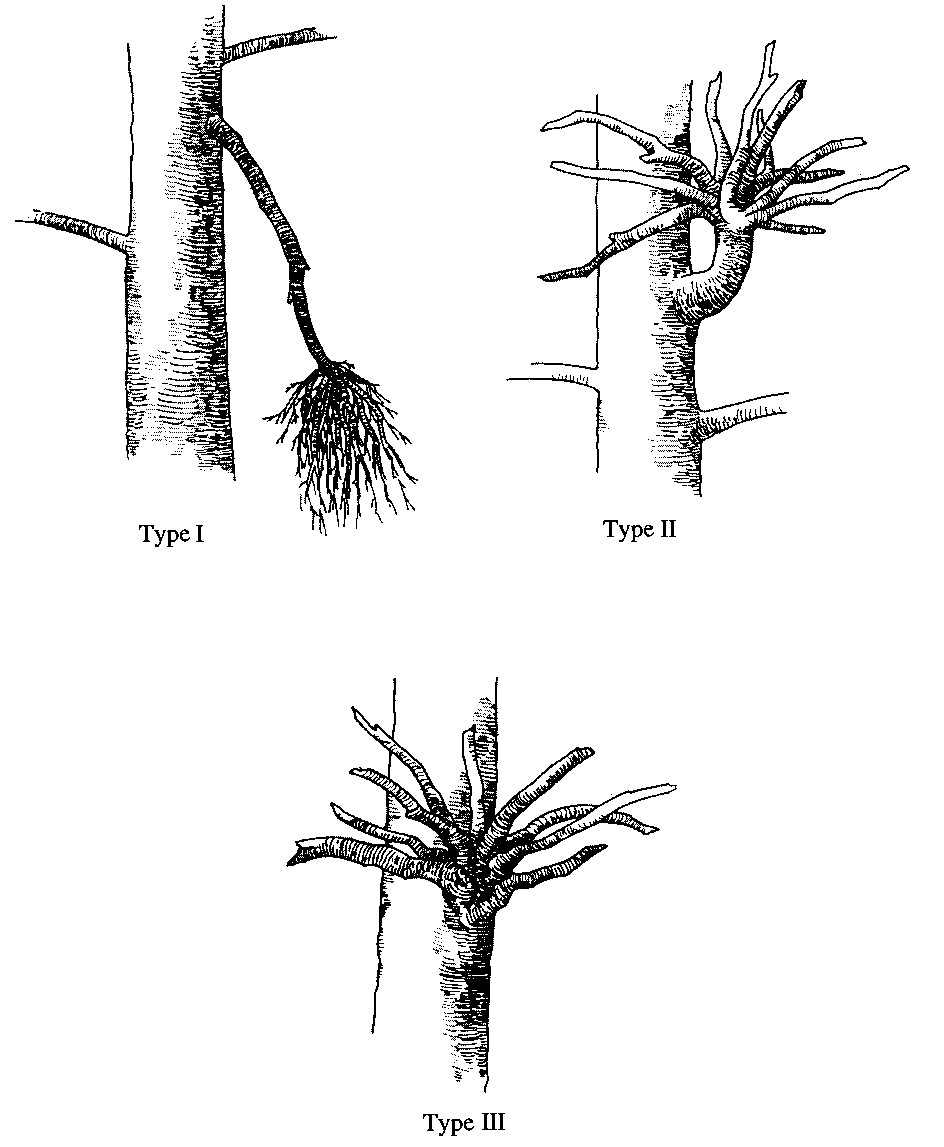
Distribution in Oregon and Washington:
Various dwarf mistletoe species are found throughout both states. Many more species occur in southwestern Oregon and east of the Cascades crest than occur on the Westside in northwestern Oregon and western Washington. Table 1 provides a summary of mistletoes occurring in Oregon and Washington.
Hosts:
Conifers. Dwarf mistletoes found in Oregon and Washington are fairly host specific, with individual dwarf mistletoe species typically being restricted to principal hosts belonging to a single conifer host genus or subgenus (Table 1).
Diagnosis:
Witches’ brooms (localized prolific branch growths)
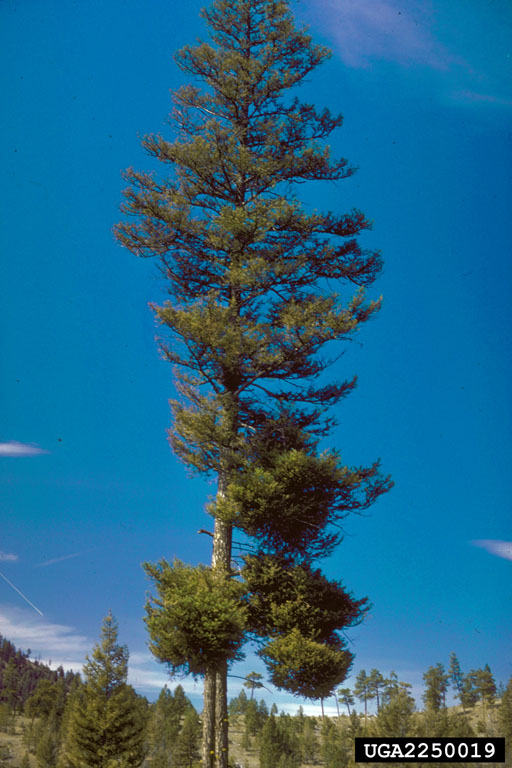
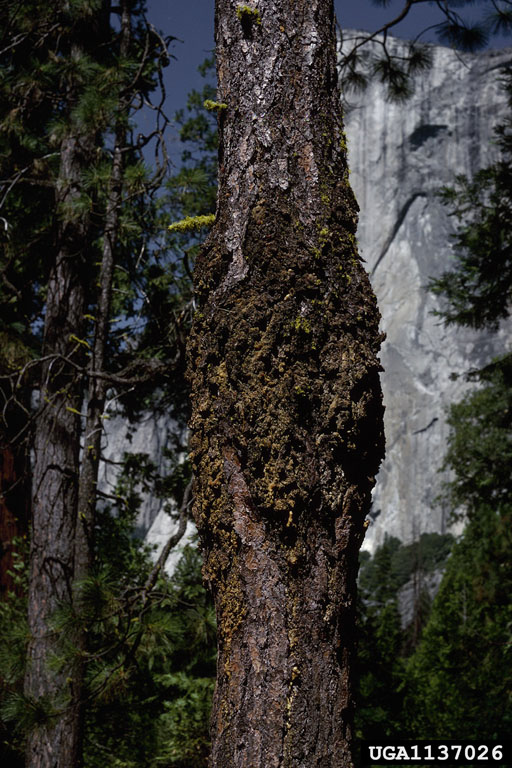
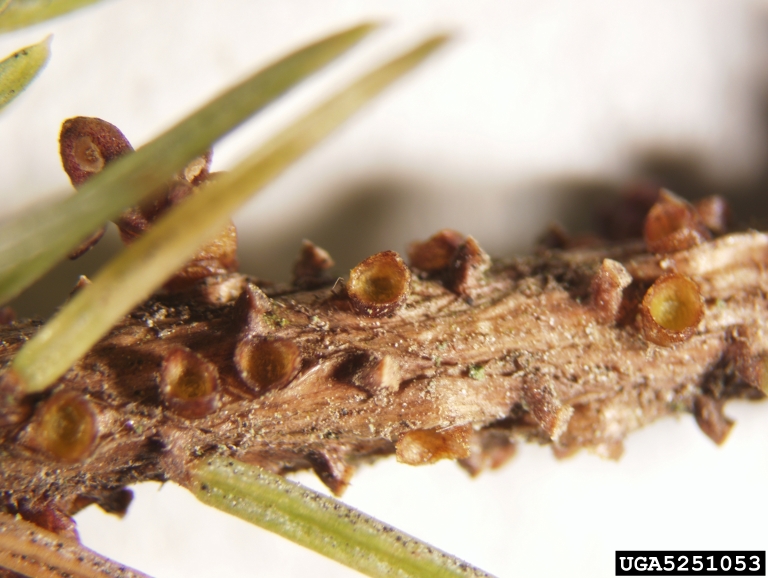
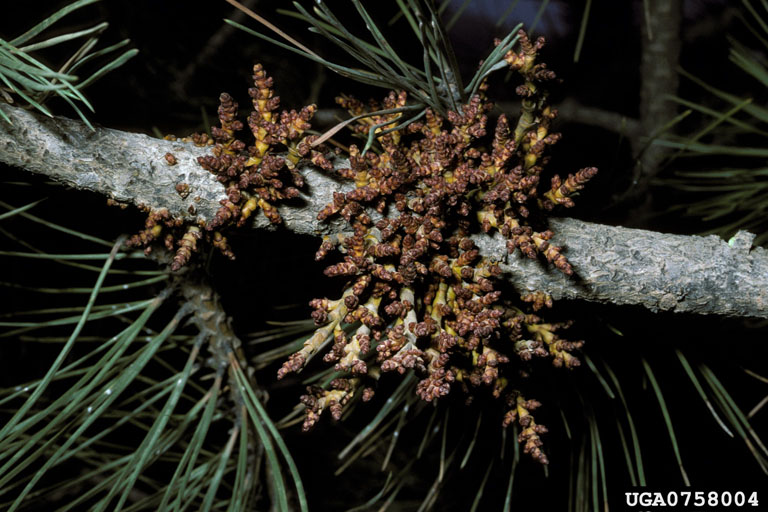
Severe infestations can cause trees to have dead tops, flat tops, dead branches, and sparse foliage throughout the crown except in the brooms.
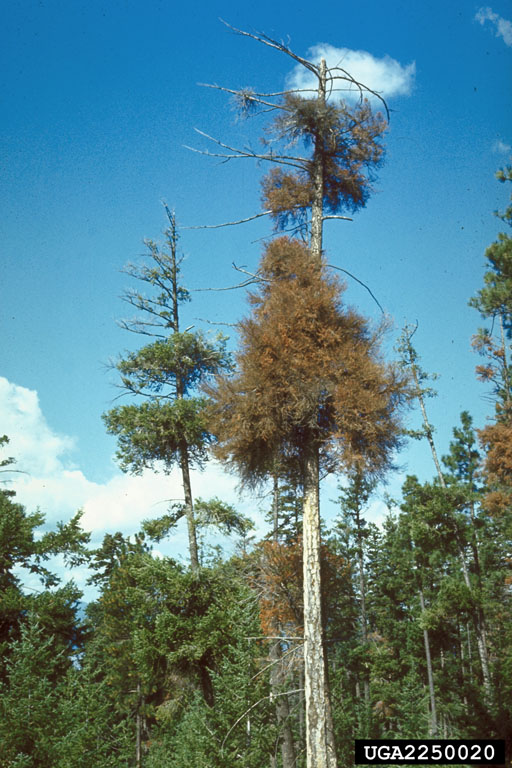
In Oregon, a canker-causing fungus called Cytospora abietis commonly invades true fir branches parasitized by true fir dwarf mistletoe (Arceuthobium abietinum). This fungus can quickly kill infected branches and is especially active during dry years, causing branch flagging (conspicuous red or recently dead branches) that usually is more apparent than signs or symptoms caused the dwarf mistletoe alone, providing an obvious visual cue to inspect for true fir mistletoe.
Life History:
Dwarf mistletoes are small parasitic plants that require a living host to survive. The dwarf mistletoe plant consists of a sinker system that is embedded in the host phloem and xylem tissues, and aerial shoots, flowers, and fruits. Individual plants are either males (pollen producing) or females (seed producing). Trees are infested by dwarf mistletoes via seeds, which are produced in small berries on female mistletoe plants. Seeds are disseminated in late summer or early fall by an explosive mechanism that is regulated by water pressure buildup inside the ripening mistletoe berry.
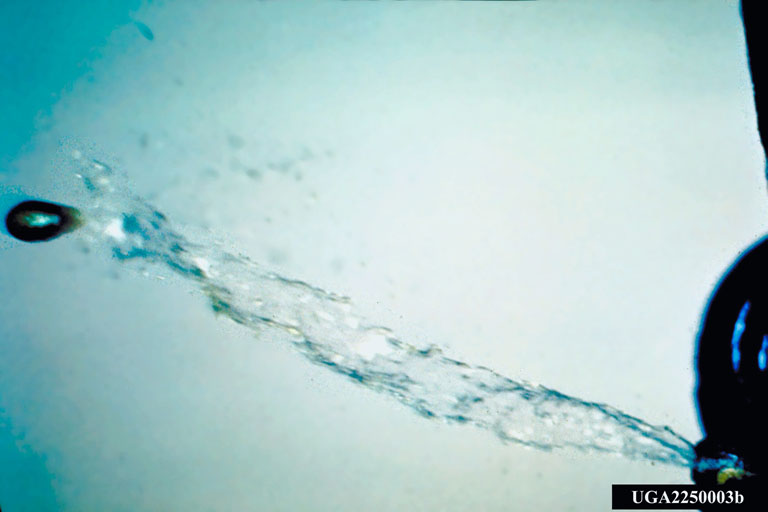
Swelling of host tissues usually occurs at the point of infection after 1 to 2 years, followed by aerial shoot production 2 to 5 years after initial infection. Flowering begins 1 to 2 years after aerial shoots appear, and fruit maturation takes at least one year. The total length of time from infection to seed production averages 4 to 5 years. Many successive crops of aerial shoots may be produced at an infection site.
Important Habitats and Spread Dynamics:
Pure or nearly pure host stands growing on poor sites, with multistoried stand structures and suppressed fire regimes, provide the most favorable conditions for the rapid spread and survival of dwarf mistletoes. Typically, most growth loss occurs in stands older than 60 years, and the degree of infection increases with increasing stand age. Tree seedlings younger than 10 years have little risk of infection.
Most spread occurs over short distances (within a tree and between nearby trees), although birds and mammals occasionally spread dwarf mistletoe over long distances when they carry the sticky seeds on their bodies. Seed dispersal distances of about 10 m or less are typical when animal vectors are not involved (Table 1). Dwarf mistletoe seeds dispersed from plants located in the upper portions of tree crowns tend to travel farther than those dispersed from lower locations. Spread is most effective from overstory trees to smaller trees of the same host species, because seeds can travel unimpeded once they clear the overstory tree crown and understory trees are showered from above with mistletoe seeds. Spread may also occur among nearby similar-sized hosts, but is less rapid, and spread in single-storied stands typically is estimated to be 0.3 to 0.6 m per year. Dwarf mistletoe may also spread upward within an infested tree crown at an average rate of 30 cm (1 foot) or less per year.
Spread rates are influenced by a variety of factors including dwarf mistletoe species, stand structure and composition, dwarf mistletoe location on the host, and host needle characteristics. Spread rates in very dense stands are lower than in more open stands because the closely spaced crowns act to trap seeds, limiting spread capability, and fewer seeds are produced due to limited light and reduced host vigor.
Generally speaking, fast-growing trees with dwarf mistletoe infestations limited to the lower third of their crown are able to outgrow infestations, but slower growing trees eventually become infested throughout their crowns.
Opportunities for Manipulation to Increase Wildlife Habitat:
Several options exist for maintaining or increasing dwarf mistletoe structure in infested stands or landscapes. One option is retention of infested trees without buffering. On most sites, especially those sites where trees are growing slowly, dwarf mistletoe infections will increase naturally in the absence of silvicultural manipulation or fire. Infected shelterwood trees may be retained without adversely affecting future stand development if the understory is comprised of predominantly non-host species.
Other options involve retention with buffering. During thinning or harvest entries, the habitat provided by brooms could be maintained with minimal adverse effects by carefully selecting patches of mistletoe-infested trees for retention in isolated “islands” surrounded by buffer areas devoid of host species (see Considerations for selecting and creating decayed wood elements and Bull et al. 1997). Mistletoe infections are likely to increase over time within buffered areas, unless the trees are growing rapidly and have only light infections in the lower crowns, or are so severely infected that they die. In some situations where buffered areas consist of single-storied or widely spaced stand structures, susceptible species could be interplanted to increase broom habitat within buffered areas. Where infested overstories are comprised of seral species and existing understories are occupied by non-host shade tolerant species, reduction or removal of the understories may be necessary before susceptible species can be interplanted.
Potential Adverse Effects:
Dwarf mistletoes weaken host trees by slowly robbing them of water and nutrients. In most forest situations, adverse effects of dwarf mistletoes usually are not significant until trees are heavily infested. Heavily infested trees may suffer severe growth loss, reduced cone and seed production, reduced wood quality, and mortality. Infected branches frequently break due to associated decay or broom size. In some cases infested trees are predisposed to mortality caused by bark beetles or drought. Heavily infested trees usually die within 10 to 15 years, though the length of time varies depending on the species of mistletoe involved, the size and vigor of the host trees, site and climatic conditions, and whether bark beetles are attracted to the infested trees.
Dwarf mistletoes are capable of spreading and intensifying over time to levels that adversely affect stand conditions. Young host stands that are heavily infested with dwarf mistletoes (usually such stands were infected by infested overstory trees) may become stagnated at a young forest stage and never develop large structure or dense cover. Heavily infested mature host stands experience high rates of mortality and are unable to provide the long-term structure and cover required by some wildlife species. In addition, heavily infested stands generally are more flammable than non-infested stands, due to large fuel accumulations from fallen trees, dead witches’ brooms, and resinous live brooms in lower tree crowns.
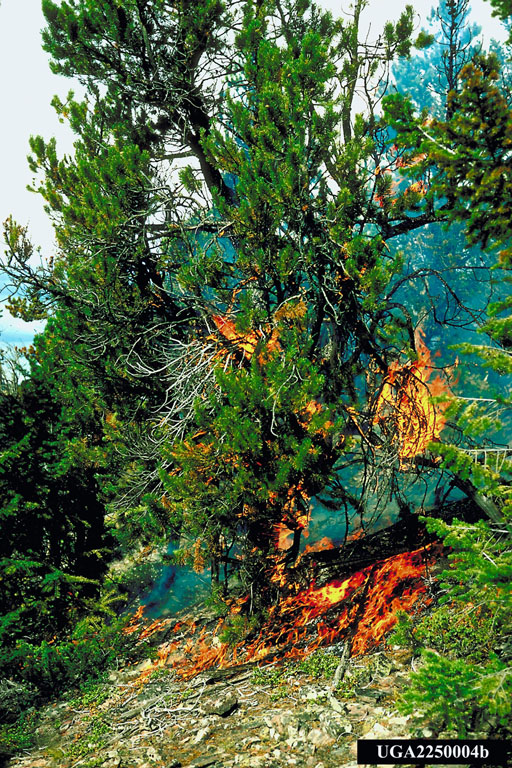
Adverse affects also may occur at campgrounds and other recreational sites, where large brooms, weakened or dead branches and stems, and dead trees caused by dwarf mistletoes present safety hazards. Heavy infestations on recreation sites shorten the life of trees that otherwise would provide valuable screening, shade, and aesthetic values.
In Oregon and Washington, dwarf mistletoes having the highest potential for causing significant effects on stand structure and composition include Douglas-fir dwarf mistletoe, larch dwarf mistletoe, western dwarf mistletoe, western hemlock dwarf mistletoe, mountain hemlock dwarf mistletoe, and knobcone pine dwarf mistletoe. The effects of dwarf mistletoes on Douglas-fir,



Current levels of dwarf mistletoes in southwestern Oregon and east of the Cascades crest in Washington and Oregon are believed to be higher than historical levels, due fire suppression during the past century.
To assist in evaluating the likelihood of adverse effects, the standard 6-class dwarf mistletoe rating (DMR) system may be used for quantifying intensity of infection in individual trees and in stands. In this system, the live crown of the tree is visually divided into thirds and each third rated on a scale of 0 to 2 (no visible to heavy infection). The three ratings are then added to obtain a tree rating, and stand or plot ratings are obtained by averaging the tree ratings of all live trees, including uninfected ones. DMR ratings of 5 or 6 usually indicate severe infestations.
How to Minimize the Risk of Adverse Effects:
Minimizing risk of adverse effects is best accomplished through prevention of heavy infestations at the stand level. Avoid retaining live infested overstory trees over susceptible understories. The deleterious impacts of dwarf mistletoes are greatest in single-species host stands, and in stands with infected overstories above susceptible understories. In pure, single-story stands growing on good sites, trees may be thinned to promote vigorous height growth so that they may outgrow the rate of mistletoe infections. Converting pure, multi-storied stands to single-storied structures will also help to reduce the rate of spread. In mixed conifer stands, non-host species could be favored during regeneration, thinning or harvest operations, to reduce the negative impacts of dwarf mistletoe on the stand as a whole. If infestation levels are already high, infested trees may be killed standing or cut to reduce infection sources.
Removal of large witches’ brooms by pruning can extend individual tree survival by many decades, and is prudent in recreation areas where natural breakage of a large broom could result in injury or property loss. On recreation sites, adverse effects are best minimized by removing heavily infested trees, pruning large brooms, and encouraging the growth of non-host trees.
Table 1. Dwarf mistletoes of Oregon and Washington.
| Arceuthobium Species (common name) | Principal Host | Secondary Host | Dispersal Distance | Distribution | Comments |
|---|---|---|---|---|---|
| A. abietinum f. sp. concoloris (true fir dwarf mistletoe) |
• white fir • grand fir |
• Pacific silver fir • Brewer spruce |
Ave =9.2 m (30 ft) |
Throughout Oregon; not found in Washington north of Klickitat County. | Effects for a given DMR are less severe than other mistletoes. Canker fungus associate may interact to cause significant effects. |
| A. abietinum f. sp. magnificae (red fir dwarf mistletoe) |
• Shasta red fir | Ave = 10.7 m (35 ft) |
Coincides with host tree ranges. | Effects for a given DMR are less severe than other mistletoes. Canker fungus associate may interact to cause significant effects. | |
| A. americanum (lodgepole pine dwarf mistletoe) |
• lodgepole pine | Ave = 10.7 m (35 ft) |
Coincides with host tree ranges. | ||
| A. campylopodum (western dwarf mistletoe) |
• ponderosa pine • Jeffrey pine |
Ave = 10.7 m (35 ft) |
Coincides with host tree ranges. | Several other factors cause similar brooming. | |
| A. cyanocarpum (limber pine dwarf mistletoe) |
• whitebark pine • limber pine |
• western white pine • mountain hemlock |
Unknown | Single verified site near Sisters, Oregon. | |
| A. douglasii (Douglas-fir dwarf mistletoe) |
• Douglas-fir | Ave = 3.05 m (10 ft) |
Throughout eastern Oregon, Washington, and portions of southwest Oregon. Generally uncommon in the Coast Range, or north of the Oregon Calapooya Divide on the west slopes of the Cascades. | Effects for a given DMR are greater than other mistletoes. Produces very large brooms. | |
| A. laricis (western larch dwarf mistletoe) |
• western larch • mountain hemlock |
• lodgepole pine | Ave = 6.1 m (20 ft) Max = 15.3 m (50 ft) |
Coincides with host tree ranges. | Brittle brooms break readily from snow loads. Larch crowns can be greatly reduced. Significant infections also may occur on lodgepole pine. |
| A. monticola (western white pine dwarf mistletoe) |
• western white pine |
• sugar pine | Unknown | Klamath Mountains of southwestern Oregon | |
| A. siskiyouense (knobcone pine dwarf mistletoe) |
• knobcone pine | Ave = 10.7 m (35 ft) |
Klamath Mountains of southwestern Oregon | ||
| A. tsugense subsp. tsugense (western hemlock dwarf mistletoe) |
• western hemlock • Pacific silver fir • noble fir • subalpine fir |
Ave = 6.1 - 9.2 m (20 - 30 ft) Max = 15.2 m (50 ft) |
Coincides with host tree ranges | Effects are usually minor until hosts are older than 120 years of age. | |
| A. tsugense subsp. mertensianae (mountain hemlock dwarf mistletoe) |
• mountain hemlock • Pacific silver fir • noble fir • subalpine fir |
• whitebark pine | Ave = 6.1 - 9.2 m (20 - 30 ft) Max = 15.2 m (50 ft) |
Coincides with host tree ranges in Oregon, infrequently occurring in Washington | Effects are usually minor until hosts are older than 120 years of age. |
References
Barrett, J.W. and L.F. Roth. 1985. Response of dwarf mistletoe to thinning: 1. Sapling growth. USDA Forest Service, Pacific Northwest Research Station, Portland, OR. Research Paper PNW-232. 14pp.
Bull, E.L., C.G. Parks, and T.R. Torgersen. 1997. Trees and logs important to wildlife in the interior Columbia River Basin. USDA Forest Service, Pacific Northwest Research Station, Portland, OR. PNW-GTR-391. 55 pp.
Goheen, E.M. and E.A. Willhite. 2006. Field guide to common diseases and insect pests of Oregon and Washington conifers. USDA Forest Service, Pacific Northwest Region, Portland, OR. R6-NR-FID-PR-01-06. 335 pp.
Harrington, M.G. and F.G. Hawksworth. 1990. Interactions of fire and dwarf mistletoe on mortality of southwestern ponderosa pine: In: Krammes, J.S., tech coord. Effects of fire management of southwestern natural resources: Proceedings of symposium; 1988 November 15-17; Tucson, AZ. USDA Forest Service, Rocky Mountain Forest and Range Exp. Sta., Fort Collins, CO. General Technical Report RM-191.: 234-240.
Hawksworth, F.G. and C.G. Shaw III. 1984. Damage and loss caused by dwarf mistletoes in coniferous forests of western North America. In: Wood, R.K.S., G.J. Jellis, eds. Plant diseases: infection, damage and loss. Oxford: Blackwell Scientific Publications: 285-297.
Hawksworth, F.G. and D. Weins. 1996. Dwarf mistletoes: biology, pathology, and systematics. B.W. Geils, tech. ed., USDA Handbook 709. Washington DC. 410 pp.
Hawksworth, F.G. 1977. The 6-class dwarf mistletoe rating system. USDA Forest Service, Rocky Mountain Forest and Range Exp. Sta., Fort Collins, CO. Gen. Tech. Rep. RM-48.7 pp.
Hudler, G., N. Oshima, F.G. Hawksworth. 1979. Bird dissemination of dwarf mistletoe on ponderosa pine in Colorado. American Midland Naturalist. 102(2):273-280.
Johnson, D.W. and F.G. Hawksworth. 1985. Dwarf mistletoe: candidates for control through cultural management. In: Insect and disease conditions in the United States, 1979-1983. Gen. Tech. Report WO-46: 48-55.
Marshall, K., M. Mamone, and R. Barclay. 2003. A survey of Douglas-fir dwarf mistletoe brooms used for nests by northern spotted owls on the Applegate Ranger District and Ashland Resource Area in Southwest Oregon. Western Journal of Applied Forestry, 18(2):115–117.
Parks, C.G., E.L. Bull, R.O. Tinnin, J.F. Shepherd, and A.K. Blumton. 1999. Wildlife use of dwarf mistletoe brooms in Douglas-fir in Northeast Oregon. Western Journal of Applied Forestry, 14(2):100-105.
Scharpf, R.F., R.S. Smith, and D. Vogler. 1987. Pruning dwarf mistletoe brooms reduces stress on Jeffrey pines, Cleveland National Forest, California. USDA Forest Service, Pacific Southwest Forest and Range Exp. Sta., Berkeley, CA, Research Paper PSW-186. 7 pp.
Steele, R., R.E. Williams, J.C. Weatherby, E.D. Reinhardt, J.T. Hoffman, and R.W. Their. 1996. Stand hazard rating for central Idaho forests. USDA Forest Service, Intermountain Research Station, Ogden, UT, Gen. Tech. Rep. INT-GTR-332. 29pp.
Website links
Western Forest Insects and Diseases: Publications and Links
Forest Insect and Disease Leaflets - Douglas-fir Dwarf Mistletoe
Forest Insect and Disease Leaflets - Hemlock Dwarf Mistletoe
Forest Insect and Disease Leaflets - Western Dwarf Mistletoe